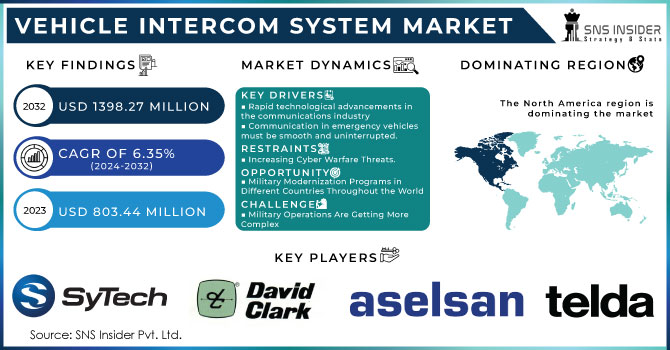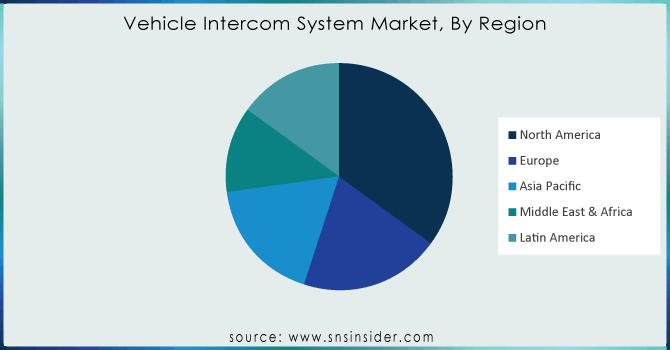Vehicle Intercom System Market Size Analysis:
The Vehicle Intercom System Market Size was valued at USD 803.44 million in 2023 and is estimated to reach USD 1398.27 million by 2032 with an emerging CAGR of 6.35% over the forecast period 2024-2032.

To get more information on Vehicle Intercom System Market - Request Free Sample Report
Vehicle intercom system New generation intercom systems used by emergency vehicles such as military vehicles and ambulances. The system is used to communicate loud noises, various natural conditions, and emergencies that provide clear communication without affecting the hearing of end users. The various components associated with automotive intercom systems such as the radio interface interface, speaker speaker, wireless intercom unit, cable / cable, and tactical ethernet switch using these intercom systems are customized. These systems are highly rigid, robust, and stand-alone systems, which can operate under all adverse weather conditions with uninterrupted communication and good stability. This system is used for communication between car radio programs and employees. The growing need for seamless and smooth communication in emergency vehicles increases the need for automotive intercom systems. In addition this feature is expected to drive the growth of the car intercom system market. In addition, growing technological advances in the telecommunications sector are expected to drive the market during forecasts.
MARKET DYNAMICS
KEY DRIVERS
-
Rapid technological advancements in the communications industry
-
Communication in emergency vehicles must be smooth and uninterrupted.
RESTRAINTS
-
Increasing Cyber Warfare Threats.
CHALLENGES
-
Military Operations Are Getting More Complex
-
Interoperability of Diverse Communication Technologies
OPPORTUNITIES
-
Military Modernization Programs in Different Countries Throughout the World
IMPACT OF COVID-19
COVID-19 has had an impact on the economies and industries of several countries. The closure of Lockdown has led to travel bans and business closures, which has affected a series of global automotive supply systems for automotive intercom systems. Therefore, it has contributed to the production and delivery of automotive intercom systems. Governments have forced publicity campaigns to halt the spread of the virus, and as a result, many organizations have begun operating at home as a safety net, leading to a dramatic decline in global car demand, thus affecting the automotive intercom systems market. In addition, the epidemic has also forced the automotive industry to rethink its business as there has been a sharp decline in car sales. In addition, COVID-19 has contributed to the development of renaming in the automotive intercom system market. The closure has also created an overflow of automotive intercom systems as manufactured products have not yet been shipped to suppliers.
The analogue category dominated the market due to the benefits it provided, such as low ownership costs and simple data processing.
Digital: The segment is predicted to increase at the fastest CAGR between 2023 and 2030. The growing emphasis of all regulatory bodies on the use of various types of digital wired or wireless vehicle intercom systems in various activities is propelling the digital segment of the global vehicle intercom system market forward. Military Vehicles This segment is expected to grow at the fastest CAGR from 2023 to 2030, owing to the increasing adoption of advanced armoured vehicles by countries such as the United States, China, and India due to advanced features such as interoperable communication systems, linkless feed systems, and others. Commercial Vehicles led the global market due to reasons such as the rising use of vehicle intercom systems in various vehicles such as SUVs, limousines, and big trucks.
Ground Support Vehicles at Airports This market is predicted to develop at a stable CAGR over the study period, owing to airport authorities' increased usage of innovative communication technologies for seamless airport operations.
The wired category dominated the worldwide market, owing to reasons such as greater awareness of the risks of cyber warfare and threats among practically every nation on the planet.
Wireless: The wired segment is predicted to develop at a faster CAGR from 2023 to 2030, owing to factors such as increased demand for wireless intercom systems in various combat and search and rescue operations for improved connectivity.
KEY MARKET SEGMENTATION
By Type
-
Wired
-
Wireless
By Technology
-
Analog
-
Digital
By Component
-
Radio Interface Unit
-
Crew Control Unit
-
Intercom User Unit
-
Loudspeaker Unit
-
Wireless Intercom Unit
-
Wire/Cable
-
Tactical Ethernet Switch
By Application
-
Military Vehicles
-
Airport Ground Support Vehicles
-
Emergency Vehicles
REGIONAL ANALYSIS
Because of the presence of important technology companies such as L3Harris Technologies, Inc. and David Clark Company, North America dominated the car intercom system market.
Europe Military modernization efforts in nations such as the United Kingdom and Germany are projected to fuel regional market growth during the forecast period.
Asia-Pacific This region's market is expected to grow at the fastest rate during the forecast period. The region's growing military sectors in countries like as China, Japan, and India are expected to boost demand for vehicle intercom systems.
World at Large Increasing cyber-threat incidents in nations such as the GCC, Brazil, and South Africa are projected to drive up demand for vehicle intercom systems in the region.

Need any customization research on Vehicle Intercom System Market - Enquiry Now
REGIONAL COVERAGE:
-
North America
-
USA
-
Canada
-
Mexico
-
-
Europe
-
Germany
-
UK
-
France
-
Italy
-
Spain
-
The Netherlands
-
Rest of Europe
-
-
Asia-Pacific
-
Japan
-
south Korea
-
China
-
India
-
Australia
-
Rest of Asia-Pacific
-
-
The Middle East & Africa
-
Israel
-
UAE
-
South Africa
-
Rest of Middle East & Africa
-
-
Latin America
-
Brazil
-
Argentina
-
Rest of Latin America
-
KEY PLAYERS
The major Players are David Clark, EID, Sytech Corporation, Teldat, Wolf Elec, Aselsan A.S., Elbit Systems, Thales Group, Cobham Plc., Harris Corporation, and other players.
| Report Attributes | Details |
|---|---|
| Market Size in 2023 | US$ 803.44 Million |
| Market Size by 2032 | US$ 1398.27 Million |
| CAGR | CAGR of 6.35% From 2024 to 2032 |
| Base Year | 2023 |
| Forecast Period | 2024-2032 |
| Historical Data | 2020-2022 |
| Report Scope & Coverage | Market Size, Segments Analysis, Competitive Landscape, Regional Analysis, DROC & SWOT Analysis, Forecast Outlook |
| Key Segments | • By Type (Wired and Wireless) • By Technology (Analog and Digital) • By Component (Radio Interface Unit, Crew Control Unit, Intercom User Unit (IUU), Loudspeaker Unit, Wireless Intercom Unit, Wire/Cable, and Tactical Ethernet Switch) • By Application (Military Vehicles, Commercial Vehicles, Airport Ground Support Vehicles, and Emergency Vehicles) |
| Regional Analysis/Coverage | North America (USA, Canada, Mexico), Europe (Germany, UK, France, Italy, Spain, Netherlands, Rest of Europe), Asia-Pacific (Japan, South Korea, China, India, Australia, Rest of Asia-Pacific), The Middle East & Africa (Israel, UAE, South Africa, Rest of Middle East & Africa), Latin America (Brazil, Argentina, Rest of Latin America) |
| Company Profiles | David Clark, EID, Sytech Corporation, Teldat, Wolf Elec, Aselsan A.S., Elbit Systems, Thales Group, Cobham Plc., Harris Corporation, and other players. |
| DRIVERS | • Rapid technological advancements in the communications industry • Communication in emergency vehicles must be smooth and uninterrupted. |
| RESTRAINTS | • Increasing Cyber Warfare Threats. |

